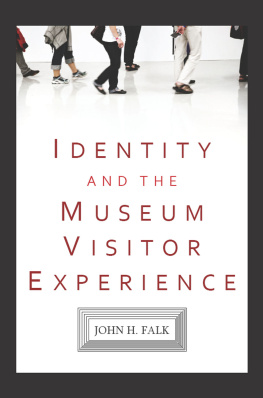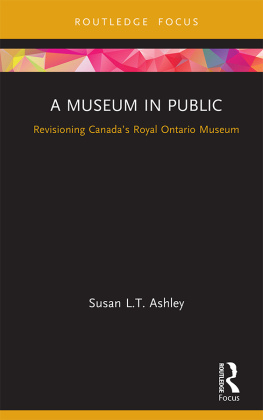
The Personalization of the Museum Visit
The Personalization of the Museum Visit examines a fundamental shift in institutional behavior in museums located in the United States and the United Kingdom. Contending that art museums have moved toward a new paradigm of public engagement, it posits that modern museum visitors are treated as self-directed clients, with the agency to make meaning for themselves. The book then considers how this change has come about, examining factors such as the onset of a new museology, an experience economy, and a marketing revolution.
Drawing on extensive research undertaken at Britains Tate Modern, the book examines a range of issues, including visitor engagement, curatorial practice, and museum management. A visit experience that is customizable to the individual visitor, in which curators and marketers work together with visitor-clients to create an experience of personalized meaning, is, Rodney argues, rising in prevalence in the art museum field, but it is also being stymied by certain structural impediments. This book examines such obstacles, including institutional division of labor, long-standing conceptions, or misconceptions, of the museums mission, and the orientation of museums toward a certain conceptual model of their visitors.
The Personalization of the Museum Visit is essential reading for scholars and students engaging with issues of visitor engagement, curatorial practice, and museum management. With a particular focus on the role of business interests and public policy, the book should also be of interest to those undertaking research in fields outside of museum and visitor studies.
Seph Rodney is an adjunct faculty member at Parsons School of Design, USA, and an editor and writer for the Hyperallergic art and culture blog. He was born on the island of Jamaica, grew up in New York City, and obtained his PhD in Museum Studies from Birkbeck College, University of London, UK.
Routledge Research in Museum Studies
Collecting and Exhibiting Computer-Based Technology
Expert Curation at the Museums of the Smithsonian Institution
Petrina Foti
Biculturalism at New Zealands National Museum
An Ethnography of Te Papa
Tanja Schubert-McArthur
Museum Innovation and Social Entrepreneurship
A New Model for a Changing Era
Haitham Eid
Diversity and Philanthropy at African American Museums
Black Renaissance
Patricia Banks
The Private Collectors Museum
Public Good Versus Private Gain
Georgina Walker
Museums as Cultures of Copies
Edited by Brenna Brita
The Personalization of the Museum Visit
Art Museums, Discourse, and Visitors
Seph Rodney
For more information about this series, please visit: https://www.routledge.com/Routledge-Research-in-Museum-Studies/book-series/RRIMS
The Personalization of the Museum Visit
Art Museums, Discourse, and Visitors
Seph Rodney
First published 2019
by Routledge
2 Park Square, Milton Park, Abingdon, Oxon OX14 4RN
and by Routledge
52 Vanderbilt Avenue, New York, NY 10017
Routledge is an imprint of the Taylor & Francis Group, an informa business
2019 Seph Rodney
The right of Seph Rodney to be identified as author of this work has been asserted by him in accordance with sections 77 and 78 of the Copyright, Designs and Patents Act 1988.
All rights reserved. No part of this book may be reprinted or reproduced or utilised in any form or by any electronic, mechanical, or other means, now known or hereafter invented, including photocopying and recording, or in any information storage or retrieval system, without permission in writing from the publishers.
Trademark notice: Product or corporate names may be trademarks or registered trademarks, and are used only for identification and explanation without intent to infringe.
British Library Cataloguing-in-Publication Data
A catalogue record for this book is available from the British Library
Library of Congress Cataloging-in-Publication Data
A catalog record has been requested for this book
ISBN: 978-1-138-04582-8 (hbk)
ISBN: 978-1-315-17177-7 (ebk)
Typeset in Sabon
by Newgen Publishing UK
Contents
For my mother, Sarah Rodney, who will likely never read this, but over the many years this research took has fully supported me in getting it produced.
For Lawrence Harding, who put up with me living on his couch for more than two years while I tried to finish the PhD thesis on which this book is based.
For my PhD secondary supervisor, Gordon Fyfe, who was as patient as humanly possible with a student with little in his background that would prepare him to undertake this kind of study.
For Travis Webb, who gave me the laptop I used to complete my PhD research, and provided bedrock emotional support when I was almost convinced I had failed.
I appreciate all these people not giving up on me.
After I undertook writing this book, I would sometimes mention it in conversation with colleagues, students, artists, curators, and other researchers, explaining that it is based on my doctoral thesis research regarding the nature of the visit to an art museum. Quite often I was asked to explain what I mean by the visit. Over the years and months of working on the thesis and this project, Ive learned to shorthand my main argument to what might be called an elevator pitch: My research examines the how the museum visitors experience has changed in the past generation, how it has lately become reconceived by curators and marketers and other museum professionals as an experience of cocreating meaning with a self-directed, self-actualized visitor. I aim to explain the underlying historical forces and movements that are being expressed in these new conceptions of the visitor and her experience. Ultimately, I am trying to explain why the experience you have in a contemporary museum of art is likely very different from the kinds of experiences your parents had. This succinct description is a good starting point, but it begs all sorts of questions.
If the person is still interested, the questions I get asked tend to break down into two categories, depending on whether the person I am speaking to had or has a professional relation to the museum, that is, has had formal education or training in museum work, in museology, or related topics.museum seems to be becoming more democratic, demonstrating growing ethnic and socioeconomic diversity in its audiences, even shifting its focus to become more oriented to serving nearby communities, thereby reaping the rewards of increasing audience numbers and visitor enthusiasm.
This is to say that the subject of visitors experiences in art museums is relevant not only to professionals and academics operating within the fields of museum studies and its (younger) sister discipline, visitor studies, but also to many other researchers, theorists, and to museumgoers in general. Ultimately this book should also be of interest to readers curious about how public institutions shape and direct their interactions with their visitors in an age of organizations retooling themselves to become more user-oriented, customer-friendly, sensitive to public critique, and reflexively aware of their own precarity within an environment where business interests and politics overlap and public opinion is often crucial to an organizations survival.








